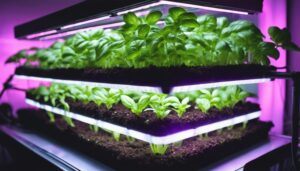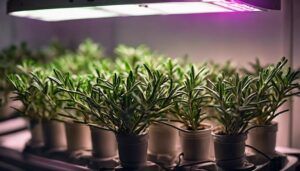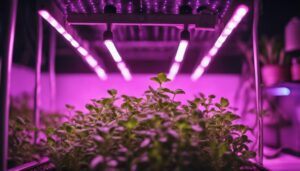To Grow Herbs Over Grow Lights
To successfully grow herbs under grow lights, you must cater to the unique light needs of your top 11 herbs. Understanding these requirements is essential for an indoor herb garden for their growth and harvest. Remember, each herb has specific lighting preferences important for ideal development. Factors like light intensity, duration, and spectrum influence their progress. By selecting the right herbs and setting up a proper grow light system, you lay the foundation for a thriving garden. Following maintenance tips guarantees healthy growth. Mastering the light requirements of your selected herbs ensures a bountiful indoor harvest.
GrowHydroHerbs TLDR
- Understand specific light needs of each herb for optimal growth.
- Choose a variety of herbs with different light requirements for a diverse garden.
- Position grow lights correctly to provide adequate light exposure for herbs.
- Monitor and adjust light cycles to support healthy growth stages.
- Regularly maintain herbs by pruning, monitoring soil moisture, and preventing pests.
Here is the list of herbs:
Benefits of Using Grow Lights for Herbs
One needs to use grow lights to successfully cultivate herbs indoors. They provide the necessary light spectrum for ideal growth. Herbs rely heavily on light for photosynthesis. This makes it vital to mimic natural sunlight when growing them indoors. Grow lights ensure that your herbs receive the right amount of light to thrive in an indoor environment. Without adequate light, herbs can become leggy, weak, and struggle to reach their full growth potential.
High-quality grow lights are designed to replicate the natural light spectrum. Thus, providing the ideal conditions for herb growth. You can control the intensity and duration of light exposure by using grow lights. This creates an environment where your herbs can flourish year-round. Properly selected grow lights will help you maintain healthy herb gardens, even in spaces with limited natural light.
Anyone looking to cultivate a successful indoor herb garden should understand the benefits of using grow lights.
Selecting the Right Herbs
So how do you select the right herbs for your indoor herb garden using grow lights?
It involves considering each herb’s unique lighting requirements, your available indoor space, and lighting conditions.

(expand on click)
Different herbs have varying light needs. Therefore, it’s essential to research the specific requirements of the herbs you wish to grow. When choosing the herb varieties, be mindful of the space and lighting available in your indoor area. That will guarantee ideal growth conditions.
To create a diverse indoor herb garden, opt for a mix of herbs with different light preferences. Understand plant growth habits and light requirements. That is key to selecting the right combination of herbs for a successful indoor herb garden.
Basil

Basil is a fantastic choice for beginners. It requires rich nutrients and thrives under 12-16 hours of full-spectrum light. Basil’s fast growth makes it a rewarding herb for hydroponic systems.
Ensure consistent water supply and maintain a pH level of 5.5-6.5. Basil is sensitive to cold, so keep the temperature between 70-80°F.
Mint

Mint grows quickly and easily in hydroponic systems. It needs moderate light, around 12-16 hours daily. Mint is resilient and can tolerate varying light intensities, making it perfect for beginners.
Keep the nutrient solution pH between 6.0-7.0. Mint spreads quickly, so regular pruning is essential to manage growth.
Cilantro

Cilantro prefers cooler temperatures and moderate light. Provide it with 12-16 hours of light to ensure healthy growth. Cilantro’s rapid growth and fresh flavor make it a great addition to your indoor herb garden.
Maintain a pH of 6.5-7.0 and ensure good air circulation to prevent bolting.
Rosemary

Rosemary requires higher light intensity, ideally 14-16 hours of bright light. It’s a bit more demanding but very rewarding. Ensure good oxygenation in the water to support its growth.
Keep the pH between 5.5-6.0 and provide adequate space for its woody stems to expand.
Parsley

Parsley thrives in hydroponic systems with 12-16 hours of light. It’s easy to grow and adds a fresh flavor to many dishes. Parsley is tolerant of varying light conditions, making it beginner-friendly.
Maintain a pH of 6.0-7.0 and ensure consistent moisture levels.
Thyme

Thyme is compact and easy to manage. It needs about 12-16 hours of light daily. Thyme’s hardy nature and minimal space requirements make it ideal for small indoor gardens.
Keep the pH between 5.5-7.0 and allow the growing medium to dry slightly between waterings.
Chives

Chives grow well under 12-16 hours of light. They add a mild onion flavor to dishes and are easy to cultivate. Chives are perfect for beginners due to their simple care requirements.
Maintain a pH of 6.0-7.0 and regularly trim the tops to encourage new growth.
Oregano

Oregano is hardy and resilient. It needs 12-16 hours of light and can tolerate various conditions. Oregano’s robust flavor enhances many dishes, making it a versatile herb for your garden.
Keep the pH between 6.0-8.0 and ensure good drainage to prevent root rot.
Sage

Sage requires minimal care and 12-16 hours of light. It’s easy to grow and adds a unique flavor to many recipes. Sage’s low maintenance needs make it suitable for beginners.
Keep the pH between 6.0-7.5 and avoid overwatering.
Tarragon

Tarragon is best grown from sprouts and needs 12-16 hours of light. It’s great for flavoring dishes and thrives in hydroponic setups. Tarragon’s specific care needs are manageable with proper light.
Keep the pH between 6.0-7.5 and avoid overwatering.
Dill

Dill prefers full-spectrum light and 12-16 hours daily. It’s versatile and adds fresh flavor to dishes. Dill is easy to grow and ideal for hydroponic systems, making it perfect for beginners.
Maintain a pH of 5.5-6.5 and ensure the nutrient solution is well-aerated to support healthy growth.
Setting Up Your Grow Light System

Position your grow lights 6-12 inches above your herb plants for best light exposure. This distance guarantees that the plants receive sufficient light without causing any light burn. As your herbs grow, remember to adjust the light height accordingly to maintain the ideal distance for their growth stages.
Utilize timers to regulate light cycles. This provides consistent exposure for your herbs. Consistent exposure aids in establishing healthy growth patterns. When setting up your grow light system, consider the light spectrum required for different growth phases. Blue light is ideal for vegetative growth, promoting strong stems and leaf development. Red light is suitable for flowering, encouraging the production of flowers and fruits.
Understand and implement the correct light spectrum for each plant. Then you can effectively support your herbs’ growth needs.
Additionally, ensure proper ventilation around your grow lights. This will prevent overheating. Further safeguarding your plants’ health and promoting a thriving indoor herb garden.
Understanding Light Requirements
Adjusting the height of your grow lights will help meet the specific light requirements of different herbs. This will aid in successful indoor gardening.
Herbs grown indoors with grow lights thrive when exposed to 12-16 hours of artificial light daily. Each herb, such as basil, parsley, and mint, has its unique light intensity needs. Some varieties benefiting from at least 6 hours of direct sunlight.
Maintaining the correct distance between the herbs and the light source is important. This is typically within 12 inches to guarantee adequate light exposure. Remember, as the distance increases, the light intensity diminishes. This impacts the growth and overall health of your herbs under grow lights.
To support successful growth one needs to match herb varieties with their specific light requirements. By meeting the light needs of your indoor herb garden, you can create an ideal environment for your herbs to flourish and thrive year-round.
Maintenance Tips for Healthy Growth
Regularly pruning your herbs encourages new growth and maintains plant health under grow lights. Trimming dead or overgrown parts stimulates the production of fresh leaves and stems. This promotes a bushier and healthier herb plant. Additionally, monitoring soil moisture levels prevents issues related to overwatering or underwatering.
Adjust your watering schedule based on the herb’s specific needs. Make sure the soil remains adequately moist but not waterlogged.

(expand on click)
Choose a balanced fertilizer to provide essential nutrients. This reduces the risk of nutrient imbalances that could harm your plants. Apply the fertilizer sparingly according to the instructions. This will support healthy growth without overfeeding.
To promote uniform growth, rotate your herb containers periodically to expose all sides of the plants to the grow lights evenly. This practice helps prevent leggy growth and encourages a more balanced development. Lastly, keep a close eye on your herbs for any signs of pests or diseases. Addressing these issues promptly is important. It helps to maintain the health and vitality of your herb garden under grow lights.
What did we Learn About Growing Herbs Under Grow Lights?
Follow the tips and guidelines outlined in this guide. You’re now equipped to successfully cultivate a thriving indoor herb garden using grow lights. Follow these tips to enjoy the benefits of homegrown herbs year-round:
- Select the right herbs
- Create a proper lighting setup
- Conduct regular maintenance
Get ready to start on your indoor gardening journey with confidence and watch your herb garden flourish in any living space.
Happy growing!
